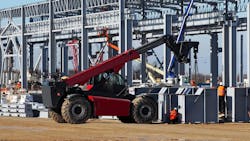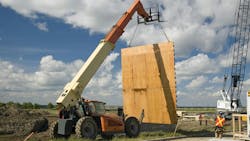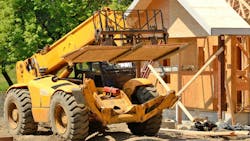Best Practices For Telehandler Safety
More on telehandler safety
- Be smart about lifting with telehandlers.
- How wireless technology has revolutionized lifting, from EHS Today.
- Stability triangle determines if telehandlers tip
Key takeaways from this article
- Understand how operating training can diminish safety hazards.
- Understand what operators need to know about lifting.
- See how maintenance contributes to telehandler safety.
Telehandlers are versatile pieces of equipment widely used on construction sites for hoisting, moving, and placing materials. Combining the capabilities of forklifts, cranes, and work platforms, telehandlers can be essential for efficient operations. Their versatility comes with significant safety risks, however, if not used properly.
To ensure the safety of operators, workers, and the work environment, adhering to telehandler safety protocols is paramount. There are many critical aspects of construction telehandler safety, including machine operation, site considerations, operator training, and regulatory compliance.
Understand telehandler hazards
Telehandlers present unique safety challenges due to their size, maneuverability, and load-handling capabilities. Some of the most common hazards associated with telehandlers include:
- Tipping over. Telehandlers can become unstable due to uneven ground, improper load distribution, or overloading. Their high center of gravity, combined with extended booms, increases the likelihood of tipping, particularly when the machine is operated at its limits.
- Load dropping. Improperly secured loads or operator errors during lifting or placing operations can lead to dropped materials, posing a risk to nearby workers.
- Collisions. Telehandlers are often operated in confined or congested areas. Poor visibility from the cab, combined with the machine’s large size, can result in collisions with personnel, structures, or other equipment.
- Mechanical failures. Poor maintenance can lead to issues such as brake failure, hydraulic leaks, or malfunctioning booms, all of which compromise safety.
- Falling from height. When telehandlers are used with work platforms, improper attachment or failure to follow safety procedures can result in workers falling.
Operator training key is to telehandler safety
Proper operator training is the cornerstone of telehandler safety. Operators must understand how to safely handle the machine under various conditions and within its operational limits. Key components of training include:
- Equipment familiarization. Operators should be trained on the specific telehandler model they will be using, as different models may have unique controls, weight capacities, and attachments.
- Load charts and capacity awareness. Operators must know how to interpret load charts to ensure that they do not exceed the machine’s rated capacity. They should also understand how boom extension and angles affect load stability.
- Regulatory compliance. Training should include knowledge of relevant safety standards, such as those outlined by the Occupational Safety and Health Administration (OSHA).
- Certification requirements. Many jurisdictions require telehandler operators to hold certifications proving they have completed approved training programs. Certification ensures that operators meet minimum competency standards for safe operation.
Inspect before lifting
Daily inspections are essential to identify potential mechanical or structural issues before they lead to accidents. A thorough pre-operational checklist should include:
- Visual Inspection. Check tires for wear, damage, or improper inflation. Inspect hydraulic hoses and fittings for leaks. Look for cracks, bends, or other damage to the boom and frame.
- Functional checks. Test brakes, steering, and lights. Verify that the horn, backup alarms, and safety devices are operational. Ensure that all controls function smoothly and as intended.
- Load-handling attachments. Confirm that forks, buckets, or other attachments are securely mounted. Ensure that the attachment is appropriate for the task at hand and that its capacity matches the load requirements.
Safe telehandler operating practices
Adhering to safe operating practices is critical to minimizing risks. Operators and site managers should implement the following guidelines.
- Proper load handling. Always secure loads with straps or other appropriate methods to prevent shifting. Position loads as close to the machine as possible to reduce leverage effects that can cause tipping.
- Awareness of ground conditions. Avoid operating telehandlers on uneven or unstable ground. Use stabilizers or outriggers when lifting heavy or high loads. Be cautious of soft soil, slopes, and trenches that may compromise stability.
- Boom and load positioning. Never exceed the maximum height or reach limits specified in the load chart. Keep the boom retracted and the load low during transport to maintain stability.
- Site communication. Use spotters or signalers when operating in congested areas or near blind spots. Communicate clearly with workers on the ground to coordinate movements.
- Speed and maneuvering. Operate at safe speeds, particularly when turning or traveling on inclines. Avoid sudden movements or abrupt stops that can destabilize the machine.
Safety working at height
Telehandlers are often equipped with work platform attachments, allowing them to be used for tasks at height. When using telehandlers for this purpose, the following precautions are essential:
- Proper attachment. Only use platforms designed and approved for use with telehandlers. Ensure the platform is securely attached and that all locking mechanisms are engaged.
- Fall protection. Workers on the platform must use appropriate fall protection equipment, such as harnesses and lanyards. Verify that the platform has guardrails and toe boards in place.
- Operator awareness. The telehandler operator must remain at the controls at all times while workers are on the platform. Avoid moving the telehandler when the platform is raised, unless it is specifically designed for such use.
Telehandler maintenance and safety
Routine maintenance is vital to ensuring telehandlers remain in safe working condition. Maintenance programs should include:
- Scheduled servicing. Follow the manufacturer’s recommended maintenance schedule for critical systems such as hydraulics, brakes, and engines. Replace worn or damaged components promptly.
- Record keeping. Maintain detailed records of all inspections, maintenance, and repairs. Ensure that documentation is readily available for review by safety inspectors or site supervisors.
- Use of qualified personnel. Only qualified mechanics or technicians should perform repairs or adjustments on telehandlers.
Comply with regulations
Compliance with industry regulations and standards is not only a legal obligation but also a key aspect of safety management. Important guidelines include:
- OSHA standards. In the United States, OSHA provides specific requirements for powered industrial trucks, including telehandlers, under 29 CFR 1910.178. Employers must ensure compliance with these standards to avoid penalties and ensure worker safety.
- ANSI/ITSDF standards. The American National Standards Institute (ANSI) and the Industrial Truck Standards Development Foundation (ITSDF) offer additional guidance for telehandler design, operation, and maintenance.
- Site-specific rules. Construction sites may have their own safety policies and procedures that exceed regulatory requirements. Operators and workers must adhere to these rules at all times, providing they are meeting the OSHA standard.
Be prepared for emergencies
Despite all precautions taken, accidents can still occur. Being prepared for emergencies is essential to minimizing injuries and damage.
- Emergency exits. Operators should familiarize themselves with the telehandler’s emergency exit procedures.
- Load stabilization. In the event of a load shift, operators should lower the boom and stabilize the telehandler immediately.
- First aid and medical response. Ensure that first aid kits and trained personnel are available on site. Have a clear plan for contacting emergency services in the event of serious injuries.
Promote a culture of safety
Finally, fostering a culture of safety on construction sites is critical to reducing telehandler-related incidents. Employers and site supervisors can promote safety by:
- Regular training and refreshers. Conduct periodic training sessions to keep operators updated on best practices and new safety standards.
- Encouraging reporting. Create an environment where workers feel comfortable reporting hazards or unsafe practices without fear of reprisal. Near-miss reporting is just as important as accident/incident reporting.
- Recognizing safe practices. Reward and acknowledge workers who consistently demonstrate safe behaviors.
Telehandlers are indispensable tools on construction sites, but their safe operation requires a comprehensive approach that combines proper training, regular maintenance, and strict adherence to safety guidelines. By understanding the hazards associated with telehandlers and implementing best practices, construction companies can significantly reduce the risk of accidents and injuries. Ultimately, a proactive commitment to safety benefits not only the workforce but also the overall efficiency and success of construction projects.
About the Author
Cory Rohs
3-E Safety Services
Cory Rohs, Board Certified Safety Professional, is owner of 3-E Safety Services.
3-E Safety Services performs third-party audits and contributes to preconstruction meetings of approximately 50 different construction projects a month. Cory enjoys figuring out issues of concern on projects and coming to an acceptable conclusion for all parties involved. The ability to listen and work through issues of concern regardless of who caused the problem and to look for acceptable solutions is one of Cory’s attributes.
Cory has performed lead inspections, asbestos inspections, mold inspections, general health and safety inspections along with other specific inspections for different clients throughout the mid-west.
He is past President of the Heart of America Chapter of American Society of Safety Engineers (ASSE) 2011-2012-chapter year and continues to remain on the board and be the advisor for the professional development conference. Also, Cory is a member of Construction Safety group and past President of the Safety Alliance which are both safety organizations for the construction industry in Kansas City metro area.


